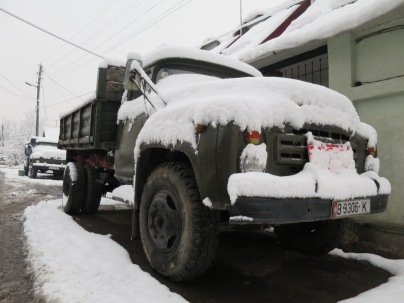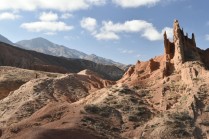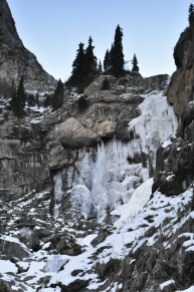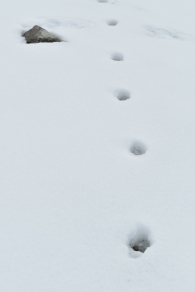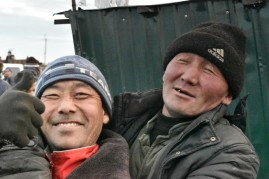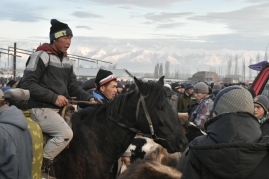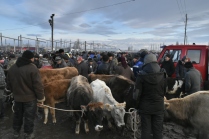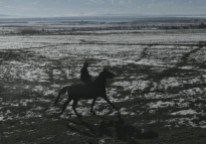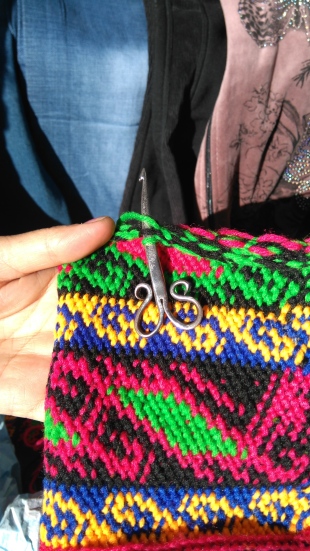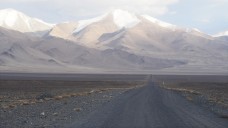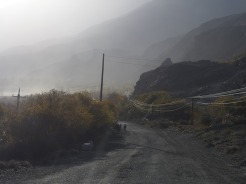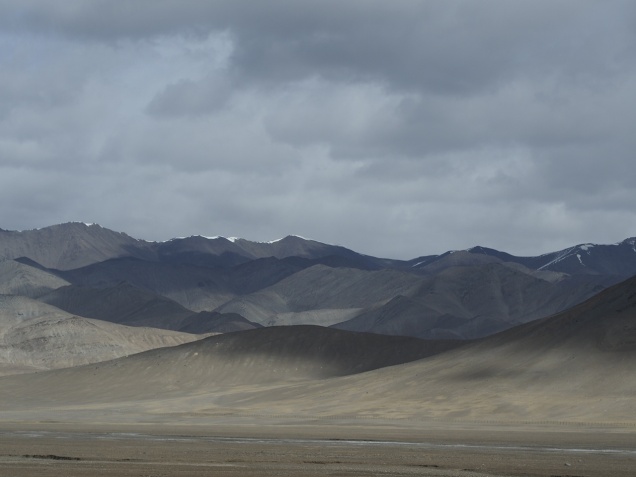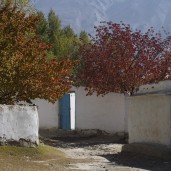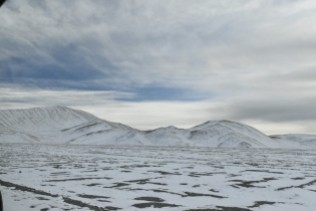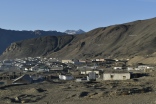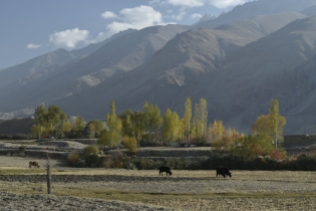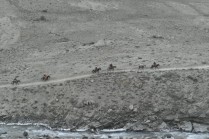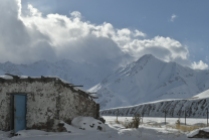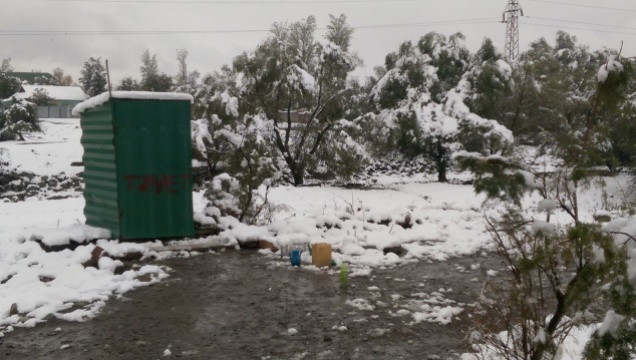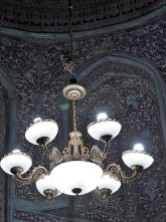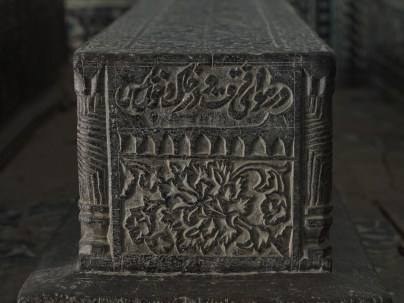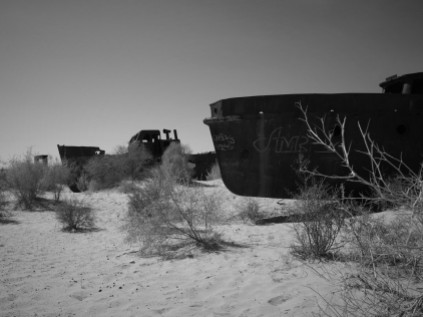Sight seeing is fairly limited in Bishkek: a few statues, the tourist shop, the square, the goose step guards who are currently ‘off’ due to the building being under repair, and the bazaar. We’d done the lot, with many visits to the bazaar and needed another diversion. Ysyk-Kol Lake did the trick: not too far away, public transport so it’s cheap, a nature reserve and local holiday spot. Angie, our hostess at the AtHouse, sorted out our first nights accommodation; a second outing for Nathan’s old rucksack and we we’re off.
Tamara, our hostess at Tamga, booked her ‘cowboy’; we were all set for a morning’s horse ride. 10 she said and the deed was done. At 10 we we’re ready: togged up, breakfasted up, camera sorted or so we thought. 10 came and went. Tamar’s cowboy couldn’t find his horses. Once he arrived it was easy to see why as they must have been deeply submerged in a briar patch. Both manes and tails were matted to a lump with burs. The ubiquitous padded sleeping mats came in handy again as they we’re draped over the saddles for our comfort and under the wooden runners to protect the horse. Plaited string reins were given, together with the usual instructions: left, right, stop & fast ahead with the use of a birch twig whip, and we were off. The first hiccup occurred as our horses headed off the track, down a small bank into a stream for a drink. Eider, our guide, already had the measure of our riding skills coming quickly across to chivvy the horses back on track. My horse was keen to be the leader of the pack. It frequently broke into a trot and occasionally a canter, much to my alarm, to make sure it’s nose was ahead. Gid was less fortunate and had the opposite problem, it wouldn’t budge. Eider soon sorted the problem. Along we went; down steep banks, across mountain streams, along mountain side sheep trails, all of which I would have baulked at on foot, until we reached an open meadow where Eider eagerly suggested we could canter. I firmly declined the offer. I’d grown quite fond of my saddle and didn’t wish to part with it.

Tamga Tash – Tibetan inscriptions

OLYMPUS DIGITAL CAMERA

OLYMPUS DIGITAL CAMERA

OLYMPUS DIGITAL CAMERA
It was a superb day, not a cloud in the sky, and a light dusting of snow visible on the sharp-edged mountains behind the foothills we climb. The dusty track rose straight from the village, up the valley. It wiggled and dipped through scrubby, hilly, grassland and a few streams. About ten times we saw a vehicle lurch up the bigger track up the valley. We greeted a couple of farmers. The two dogs were annoying; otherwise, outside the village it was just us.
We ambled back down, once I’d managed to convince my horse we weren’t going to canter for home the whole way. That was until a rare occasion when we’d dropped behind and watched three dogs aggressively worrying the two horses ahead; one hanging off the tail of Eider’s horse. It didn’t seem such a bad idea when my beast took flight and delivered me some 30 metres up the track to the front of our group again, with Eider brandishing his whip at the dogs as I flew by.
Fairytale Canyon

OLYMPUS DIGITAL CAMERA

OLYMPUS DIGITAL CAMERA

OLYMPUS DIGITAL CAMERA

OLYMPUS DIGITAL CAMERA

OLYMPUS DIGITAL CAMERA

OLYMPUS DIGITAL CAMERA
Barskoon Valley Waterfall

Taken more or less at the waterfall, but looking the other way. Hard to believe it’s the same day – the waterfall must be shaded most of the day.
Around Tamga

OLYMPUS DIGITAL CAMERA

OLYMPUS DIGITAL CAMERA

OLYMPUS DIGITAL CAMERA

OLYMPUS DIGITAL CAMERA

OLYMPUS DIGITAL CAMERA
Moving on from Tamga was entertaining in itself. Tamara had warned us that the bus timetable was approximate, not deterring an ambitious driver from speeding away early despite the bus having a schedule. True enough, 15 mins early we were chased up the road by the bus that did a quick flit round and was off again.
Being already full didn’t deter a further four of us piling on. I was given a seat as usual, with Kyrgyz politeness showing deference to age. On this occasion it may have been the short straw. Gid clung to the single roof rail in a throng of people who surged forward when someone want to depart, until one burst out, whereupon, a ripple of people retreated in a backwash. I was perched on an upturned metal, bottle crate; one leg slowly going numb. My face was approximately at arse height as I sat amongst the throng. One pair of legs squeezed mine in a pincer gripe as I tried to casually glance away. Gradually, as we passed through the villages, space became available. I moved to a comfy seat to admire my former perch and truly admire the view. My admiration sank as a man near us repeatedly rasped up a mouthful of spit ready to gob. Inhibited, perhaps, by the enclosed space the final deed was unfinished, much to our relief.
Karakol Valley – Walk up to the Ski Resort

OLYMPUS DIGITAL CAMERA

OLYMPUS DIGITAL CAMERA
Karakol Museum
Karakol Animal Market
The animal market, Angie from the AtHouse in Bishkek had said, was quite a spectacle. The biggest in the region the Lonely Planet guide claims. For once we were in the right place at the right time. I woke at 5:50 my internal alarm well tuned in and was instantly absorbed by thoughts of the animal market. Early in the morning, all over by 10 were phrases ringing in my head.
I got a groan or two out of Gid, who mentioned something about 01:30 bed time; 6am wasn’t going to happen for him. I lay there trying to content myself with thoughts such as; we’d seen animals at Kumtepa Bazaar in Margilon so presumably it would be similar but bigger. We’d also seen herds of animals spilling out onto the dual carriageway way-back-when so I had conjured up something in the middle: loads of wild fowl, loads of herds and maybe a pen or two like our now discontinued sheep fair, in Sussex. But my thoughts were running wild. I’m here, I’m awake, my only chance.
I bounded out of bed and shortly after was ready to leave. Our windowless room gave no hint of the pitch black outside. Gid, now awake, agreed to come and let me out. Through one locked door, on to the next, but the final door was locked and we couldn’t find the key. Our efforts had woken the receptionist who came to investigate. By now Gid was fully sort of awake and agreed to join me. The receptionist phoned a taxi, a whole 70 som, to save us the 30min walk.
I became apprehensive sitting in the taxi waiting for Gid. I’d dragged him out and it was still pitch black. What on earth would we be able to see? Nearing the venue the roads were becoming more and more blocked by lorries whose loads were nowhere to be seen.
Spilling out of the taxi into the dark, we followed the throng; many people had torches but ours were tucked up in bags at the hostel. Most people were leading small flocks of sheep, the odd single one or cows, through copious amounts of ‘mud’. All were either lining the edge of the road together with the vehicles or squeezing along it. We went with the flow bearing left into a large opening stuffed full of cows and horses. As there was barely anywhere to stand we tried to tuck in at the edge, finding a couple of rocks raised us up to get a better view. Traffic passed backwards and forwards; all squeezing through. The occasional beast refusing to budge. The huge area was absolutely filled. As the sun rose the spectacle opened out before us; deals started to take place, animals were inspected and some exchanged hands.
-

-
Never mind that, got a light?
-

-
I’m kinda fond of this calf, not sure I want to sell it!
-

-
They never did nail the deal. I think the wad offered was about 8,000 com, that’s roughly $100.

This was in Karakol bazaar the previous evening

OLYMPUS DIGITAL CAMERA

OLYMPUS DIGITAL CAMERA

OLYMPUS DIGITAL CAMERA

OLYMPUS DIGITAL CAMERA

OLYMPUS DIGITAL CAMERA

OLYMPUS DIGITAL CAMERA

OLYMPUS DIGITAL CAMERA

OLYMPUS DIGITAL CAMERA

OLYMPUS DIGITAL CAMERA

OLYMPUS DIGITAL CAMERA

OLYMPUS DIGITAL CAMERA

OLYMPUS DIGITAL CAMERA

OLYMPUS DIGITAL CAMERA
Cholpon-Ata
Petroglyph park dated 8th century BC – 5th century AD

OLYMPUS DIGITAL CAMERA

OLYMPUS DIGITAL CAMERA

OLYMPUS DIGITAL CAMERA

OLYMPUS DIGITAL CAMERA

OLYMPUS DIGITAL CAMERA

OLYMPUS DIGITAL CAMERA
From the bus on the homeward journey
I shall miss the ‘Stans’ as we move on into India. I have grown quite fond of the vast plains dotted with numerous herds of horses, cows, sheep & goats as they mooch across from one side to the other in search of a mouthful to eat. Especially here where the plains span right across to the foothills of the snow capped mountains. Herdsmen, frequently on horseback grace the scene. Their former nomadic lifestyle is evident with ‘sheep’s people’ high up on the mountains together with the occasional sight of a yurt.
Passing along the lakeside highway idly admiring the view, with vast expanses of golden ‘fields’ has been delightful. Hay stacks piled high in gardens nestling between fruit trees, on roof tops or jammed up beside the house. The houses, no frills, working machinery sits amid the ancient relics, museum piece tractors splutter along with over filled trailers, donkeys dwarfed as they trudge along with the last of the seasons crops. All add to the atmosphere that for me captures rural Kyrgyzstan.




















